Using backscreens
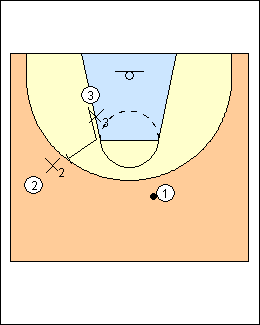 | 1 Dave Smart On any screen, you need the right angle, and disguise by the screener and cutter (sell opposite). The xscreener is the most important defender, the passer is the most important attacker (don't use coaches in practice) On a backscreen, the cutter sells opposite with his eyes and his body as needed (take xcutter one step higher if he is denying, step towards the ball if he is zoning up, forcing a denial or allowing a basket cut). The screener steps hard up the lane as though looking for the ball (if his defender doesn't play him, take the entry and 2 goes backdoor). The screener head hunts, don't leave a normal step off in practice, to avoid injuring xcutter and to get the right angle (if in doubt, move closer to the passer). Screen at the 3-point line. The passer must watch xscreener. Here we have a wing-to-wing backscreen, not little-to-big or big-to-little. |
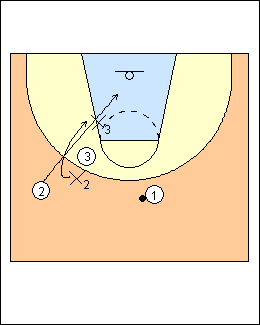 | 2 The xcutter can a) jam, force a basket or backdoor cut (shown), and chase, or b) jump hard to the ball (force a flare or switch). If xcutter steps up to jam the cutter, the cutter steps back, takes one step at his defender to freeze him then goes high (basket cut) or low (backdoor) opposite the defender. He goes by the screener shoulder to hip, and swims with an elbow in his back. The cutter should focus on getting a shot or close-out for the screener - cut inside and finish the cut (don't round it), attack the rim, make xscreener stay with him. The screener's first move is to see if he can slip the screen (unlikely on a basket cut, with xscreener hedging high), or step back for a pass. The passer has to be patient. Swing the ball when it's on the side, but give it a chance when it's in the middle of the floor on attack. If xcutter bear hugs the cutter, they used to talk about just walking into him, but they just get pushed further off, so instead of trying to fight him the cutter jams off (steps back) to make him make a choice and sells opposite the most light, taking one step at him to freeze then going hard backdoor or basket cut. |
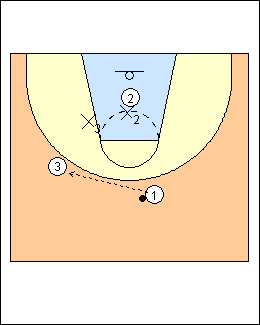 | 3 Here O3 steps back for a pass. If xscreener sags off, the screener will get the pass; if xscreener plays up, the cutter will. coachesclipboard.ca - backscreen to swim-back - a small-to-big backscreen can be used to get the ball inside and relieve pressure. The post must cut shoulder to shoulder to force the xscreener to help, take the cut toward the front of the rim to force the post defender higher - above the line of deployment - and not cut past the defender, allowing the defender to easily get over top and front or side front. The post swims back by taking his baseline arm over top and in front of the post defender and steps across the top foot of the defender with his baseline foot. The passer may need to take a baseline dribble to improve the passing angle. Other tactics to get the ball inside include a duck-in, downscreen to post-up, high-low downscreen, curl the post, and flex duck-in. |
 | 4 Most teams force a flare or switch on a backscreen. To force the flare, the xcutter jumps to the ball and xscreener gives a gap for him to get through (jumps to the ball and keeps a triangle). The passer is watching xscreener, if he is triangled (playing it properly), the passer is almost taking a direct pass to the screener out of play, 9 out of 10 times the cutter will make a pass to the screener. The screener is still the guy who is likely going to get it if we're going to score without putting the ball on the floor, but he's going to get it from the cutter. The screener is going to be patient if xscreener is triangled, but if xscreener gets straight-lined (between the screener and the basket) or expects a hedge (on a backdoor cut) and steps that way, then the passer's read is a straight slip by the screener. The screener no longer has to head-hunt so he readjusts (it's just a pivot, generally it's a front pivot, a reverse pivot will get him closer to the basket), the cutter gets to the shoulder and flares off the screen to the wing (baseline not ballside foot closest to the screen, reverse pivot and step back - he doesn't turn his back to the ball). The passer will pass it early to the cutter (on the cut) if he's not comfortable with the read the cutter is going to make if the passer holds the ball. On air time of a pass to the cutter, depending on his matchup the screener reverse pivots and seals (he's stronger than his defender) or cuts to the basket (he's quicker but not stronger), try to get a quick layup then move. Everything they do offensively is based on the match-up, know who you are and who is covering you. |
 | 5 The passer can hold the ball for a two-count if he has total trust in the cutter. If xcutter goes under the flare screen, the cutter makes a hard basket cut inside, forcing two defenders to play one. The screener reads the situation, if he knows that the passer will hesitate and let the cutter make a read, there's no rush for the screener, he reads xcutter, it's not an automatic go to the basket. They don't necessarily do this in their offence, but when they run sets late in games with the players he wants. |
 | 6 If xcutter goes over the flare screen, the cutter flares then makes a hard cut backdoor. A lot of defenders will try to gamble and stay in the passing lane trying to get a steal. In a game situation ( 5 on 5), the point guard must make the pass to the side of the floor the cutter is coming from. Ideally he wants guys going to the basket even when they flare, hesitate, make a read, and make a backdoor or basket cut based on what the defender does. He doesn't like a pass and shot on the flare, it's a soft way to play. If the defenders don't switch, you should be getting something good out of a backscreen. |
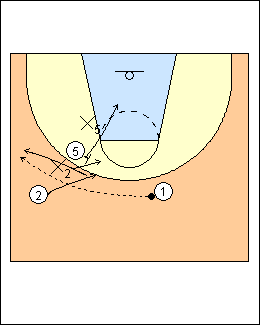 | 7 On a post to guard backscreen, the defence wants the post on the perimeter, forces the cutter backdoor, the xscreener sags and cheats baseline to help because the screener can't shoot from outside. The offence turns it into a flare situation (don't go where you are useless). The cutter first cuts hard towards the middle as though his defender had jumped to the ball, then uses the flare screen, the passer hits him on a one-count (not waiting for a late pass on a basket or backdoor cut, since that would get the post on the perimeter). The screener posts up. The passer still looks at the screener first, anytime his defender cheats baseline it's a straight slip on eye contact with the passer. |
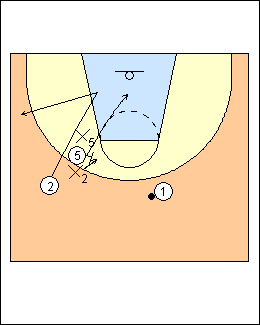 | 8 Switch The xcutter jumps to the ball and the defenders come together to prevent a slip by the screener. The screener readjusts to set a flare screen, thinking the defence is forcing a flare. The cutter gets to the screen and sees xscreener stepping up, instead of the flare he makes a hard cut to the basket (the block) then triangles out, right away the screener slips hard to the rim to sit and seal on a mismatch, or to beat the defender to the rim if the screener is quicker but not as big or strong. Set ballscreens if you know the other team switches every screen. |
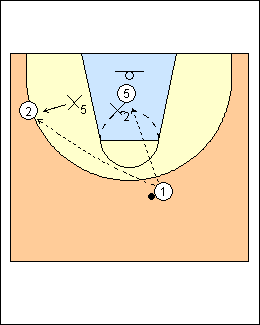 | 9 Even if the defence does a good job of switching you get mismatches where you want them. You get a mismatch then a close-out big on little (especially if X5 stays to defend a slip by the screener), or a post up with the ball entered from the point guard at the top (Carleton enters from the top 80% of the time). Ignore the 3-point line, go inside to the mismatch. Most of Carleton's screens are little to big. Attackers can cause confusion even on same-size screens (triangle it). They don't mess around with running offence if teams are going to get up the line and deny everywhere. He doesn't care what they do offensively so long as the ball gets to 8 feet, and you've got a problem if one of your main ballhandlers has the ball in the middle of the floor and can't get the ball to 8 feet. They take it away by not dribbling up top with anybody who doesn't have a match-up, it just zones everything up. They don't have a point guard, it depends on who you put on his guys. |
This page was made with Basketball playbook from Jes-Soft